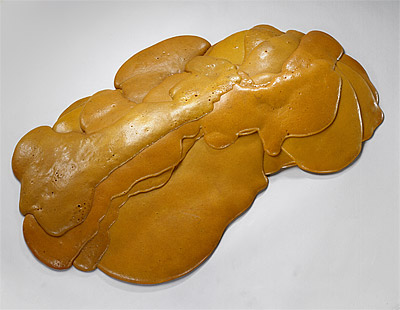Lynda
BENGLIS
United States of America
1941
Untitled (Polly's pie II)
1968
pigmented polyurethane foam
15.2 (h)
x 139.7 (w)
x 83.8 (d)
cm
Courtesy of the artist and Cheim & Read, New York
© Lynda Benglis. Licensed by VAGA & VISCOPY, Australia
‘Her works invite recognition, whether in the mind or at the fingertips or in the gut, or sensual feelings that might be mild and pleasant or wrenching and grotesque, but are in any case humanly true. After all, disgust no less than desire is an erotic emotion …’[1]
Lynda Benglis began to work with wax, latex, foam and other synthetic materials in the late 1960s and 1970s. Her sumptuous, often richly coloured floor works have been described as ‘fallen’ paintings; they could be Abstract Expressionist or Colour field paintings but without the canvas, stretcher or indeed any support.[2] In the surface and sculptural mass of a work such as Untitled (Polly's pie II) 1968 we see the evidence of the artist’s manipulation of a once-liquid substance—it ‘freezes’ the artist’s gesture. This nearly flat, monochrome, layered, bulbous floor piece is distinctly nasty in effect. Its lava structure and horrid colour suggest internal or bodily origins.
Minimalism had no sense of theatre for Benglis: she rejected its hard edges, austerity and industrial methods.[3] Instead she actively exploited the performative elements of sculpture, the acts of pouring and shaping liquid materials, and embraced seemingly accidental forms. In reality her control over technique and materials in a work such as Untitled (Polly's pie II)—mixing the polyurethane and resin, incorporating the pigment and managing the quick-drying liquid―reveals skills learnt from experimentation. Later she poured materials into corners and made works in mock-homage to her male contemporaries and artistic forebears.[4] Her works play on dualisms of feminine and masculine, biomorphic shape versus hard edge or geometric minimalism, materiality and creative sensuality.
The skin-like, pitted surface of Untitled (Polly's pie II) and its single colour draw attention to its underlying forms. Alchemical possibilities, baking and domestic science, as well as other chemical reactions come to mind.[5] In a review of her 2004 survey show, Robert G Edelman described Benglis’s sculpture as ‘the erotics of Anti-Form’. He regards the movement implicit in these works as particularly ‘Dionysian’: they flow and drip, they sparkle and shine, they twist and turn into amorous postures.[6]The artist is not coy about bodily associations―going so far as to liken the ‘flow’ of another early polyurethane work to an orgasm―but she is also humorous and deliberately provocative.[7] The joyous abandon of Benglis’s work is rather catching. She usually titles her works after friends, supporters of her works or with reference to other artists. We may imagine this ‘pie’ given to Polly was a lot of fun to make.[8] The sheer audacity of Untitled (Polly's pie II) continues to impress 40 years after its making.
Lucina Ward
Curator
International Painting and Sculpture
National Gallery of Australia, Canberra
[1] Peter Schjeldahl, ‘Lynda Benglis: body and soul’, in Lynda Benglis: 1968–1978, University of South Florida, Tampa, 1980, p 187 and quoted in Susan Krane, Lynda Benglis: dual natures, High Museum of Art, Atlanta, 1991, pp 15–16
[2] See for example, Fallen painting 1968, Albright-Knox Art Gallery, Buffalo NY (Gift of Michael Goldberg, Lynda Benglis and Paula Cooper, 1992). A 1970 article showed Benglis pouring her work, juxtaposing these images with one of Pollock working on the floor―David Bourdon, ‘Fling, dribble and drip,’ in Life, 27 February 1970―while various other commentaries, including the artist’s, discuss the impact of Helen Frankenthaler’s work on Benglis.
[3] See, for example, Ned Rifkin’s interview with the artist in Early work, The New Museum, New York, 1982, quoted in Susan Krane, Lynda Benglis: dual natures, High Museum of Art, Atlanta, 1991, p 42
[4] Her first corner piece is For Carl Andre 1970, Modern Art Museum of Fort Worth, Texas (Museum purchase, The Benjamin J Tillar Memorial Trust, Acquired in 1970); see also Odalisque (Hey, Hey Frankenthaler) 1969, Dallas Museum of Art (DMA/amfAR Benefit Auction Fund).
[5] See, for example, Priscilla Pitt’s interview with the artist in Lynda Benglis: from the furnace, Auckland City Art Gallery, Auckland, in association with the Auckland International Artist-in-Residence Programme, 1993, at p 21
[6] Robert G Edelman, ‘In Pursuit of the Organic’ at http://www.artnet.com/Magazine/reviews/edelman/edelman4-12-04.asp (accessed March 2009)
[7] In 1975, the artist was quoted: ‘All of my art is erotic, suggestive … It is about female sexuality, about being a woman.’ See Dorothy Seiberlin, ‘The new sexual frankness: goodbye to hearts and flowers,’ New York Magazine, 17 February 1975, p 42, quoted by Whitney Chadwick, ‘Balancing act: reflections of postminimalism and gender in the 1970s’, in More than minimal: feminism and abstraction in the ’70’s, Rose Art Museum, Brandeis University, Waltheim, 1996, at p 18; refer also to Susan Krane, Lynda Benglis: dual natures, High Museum of Art, Atlanta, 1991, at p 42; the orgasm comment was in reference to For Carl Andre
[8] The artist has commented that Polly was a ‘rosy and plastic’ person; she owned the first ‘pie’, a smaller, related work. The location and colour of Polly’s pie I is not known

